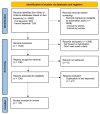Consequences of Hybridization in Mammals: A Systematic Review
- PMID: 35052393
- PMCID: PMC8774782
- DOI: 10.3390/genes13010050
Consequences of Hybridization in Mammals: A Systematic Review
Abstract
Hybridization, defined as breeding between two distinct taxonomic units, can have an important effect on the evolutionary patterns in cross-breeding taxa. Although interspecific hybridization has frequently been considered as a maladaptive process, which threatens species genetic integrity and survival via genetic swamping and outbreeding depression, in some cases hybridization can introduce novel adaptive variation and increase fitness. Most studies to date focused on documenting hybridization events and analyzing their causes, while relatively little is known about the consequences of hybridization and its impact on the parental species. To address this knowledge gap, we conducted a systematic review of studies on hybridization in mammals published in 2010-2021, and identified 115 relevant studies. Of 13 categories of hybridization consequences described in these studies, the most common negative consequence (21% of studies) was genetic swamping and the most common positive consequence (8%) was the gain of novel adaptive variation. The total frequency of negative consequences (49%) was higher than positive (13%) and neutral (38%) consequences. These frequencies are biased by the detection possibilities of microsatellite loci, the most common genetic markers used in the papers assessed. As negative outcomes are typically easier to demonstrate than positive ones (e.g., extinction vs hybrid speciation), they may be over-represented in publications. Transition towards genomic studies involving both neutral and adaptive variation will provide a better insight into the real impacts of hybridization.
Keywords: adaptive introgression; genetic swamping; hybrid speciation; hybrid zones; hybridization; mammals; outbreeding depression.
Conflict of interest statement
The authors declare no conflict of interest.
Figures



References
-
- Mayr E. Animal Species and Evolution. Belknap; Cambridge, MA, USA: 1963.
-
- Arnold M.L. Natural Hybridization and Evolution. Oxford University Press on Demand; Oxford, UK: 1997.
-
- Nesi N., Nakoune E., Cruaud C., Hassanin A. DNA barcoding of African fruit bats (Mammalia, Pteropodidae). The mitochondrial genome does not provide a reliable discrimination between Epomophorus Gamb and Micropteropus pusillus. C. R. Biol. 2011;334:544–554. doi: 10.1016/j.crvi.2011.05.003. - DOI - PubMed
Publication types
MeSH terms
Grants and funding
LinkOut - more resources
Full Text Sources
Research Materials
Miscellaneous

